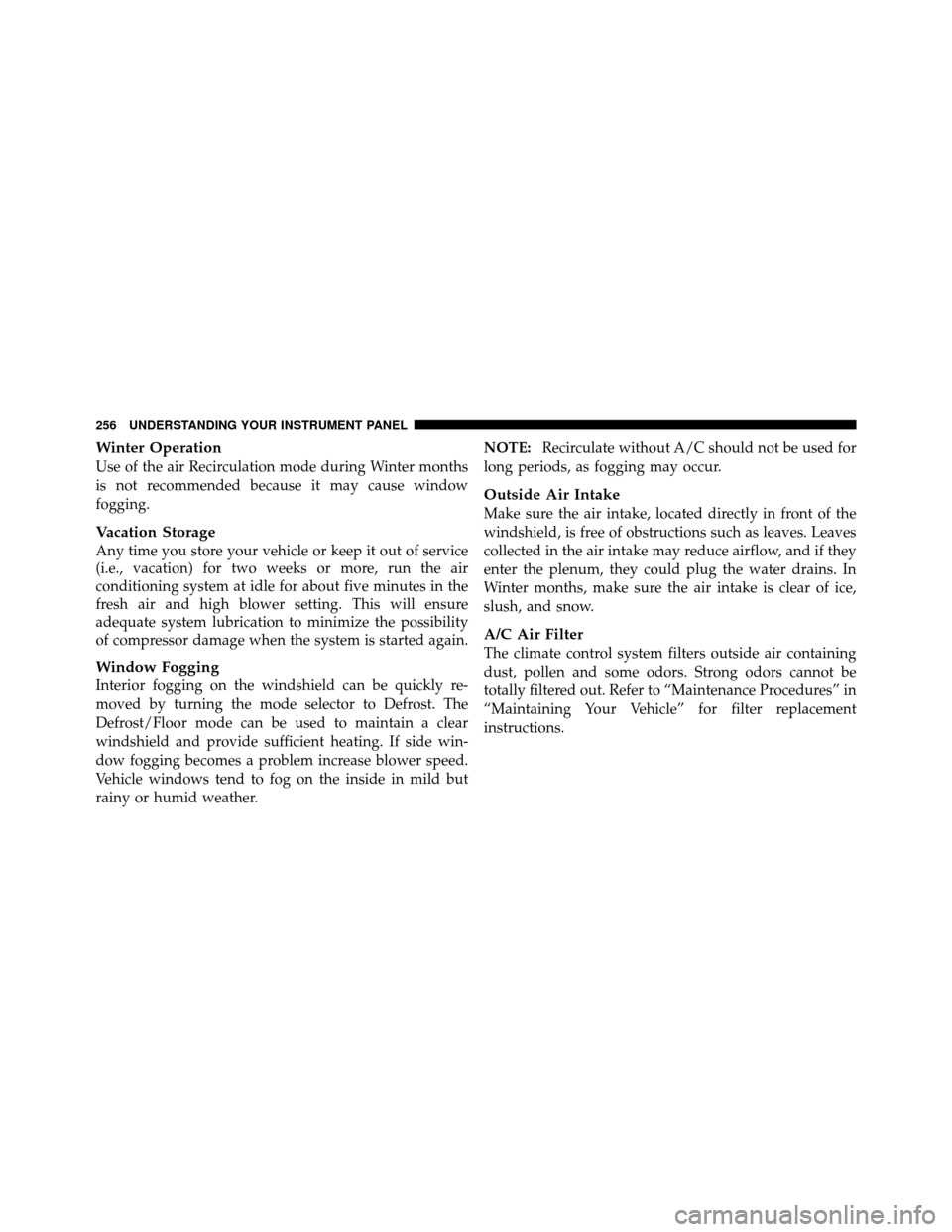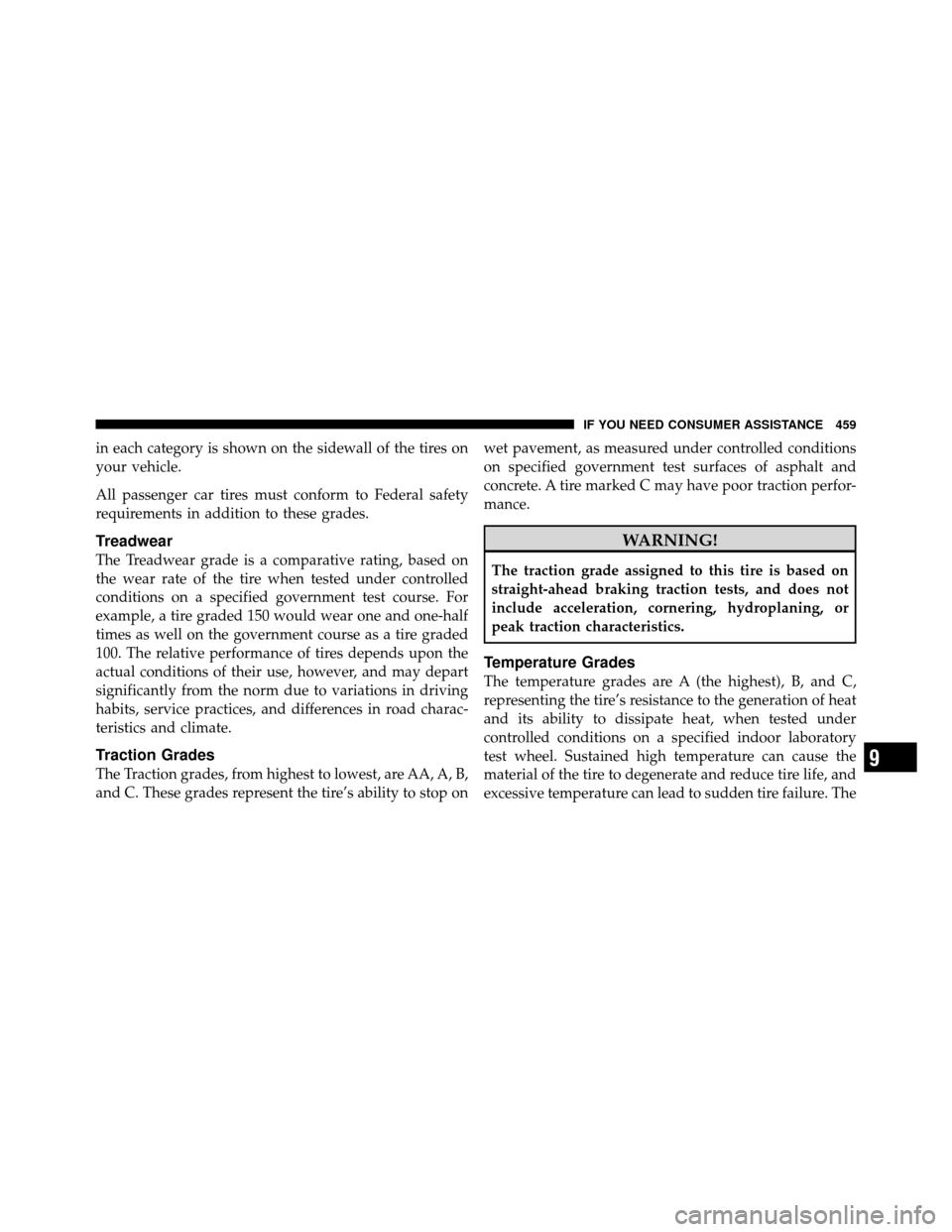Page 257 of 484

Winter Operation
Use of the air Recirculation mode during Winter months
is not recommended because it may cause window
fogging.
Vacation Storage
Any time you store your vehicle or keep it out of service
(i.e., vacation) for two weeks or more, run the air
conditioning system at idle for about five minutes in the
fresh air and high blower setting. This will ensure
adequate system lubrication to minimize the possibility
of compressor damage when the system is started again.
Window Fogging
Interior fogging on the windshield can be quickly re-
moved by turning the mode selector to Defrost. The
Defrost/Floor mode can be used to maintain a clear
windshield and provide sufficient heating. If side win-
dow fogging becomes a problem increase blower speed.
Vehicle windows tend to fog on the inside in mild but
rainy or humid weather.NOTE:
Recirculate without A/C should not be used for
long periods, as fogging may occur.
Outside Air Intake
Make sure the air intake, located directly in front of the
windshield, is free of obstructions such as leaves. Leaves
collected in the air intake may reduce airflow, and if they
enter the plenum, they could plug the water drains. In
Winter months, make sure the air intake is clear of ice,
slush, and snow.
A/C Air Filter
The climate control system filters outside air containing
dust, pollen and some odors. Strong odors cannot be
totally filtered out. Refer to “Maintenance Procedures” in
“Maintaining Your Vehicle” for filter replacement
instructions.
256 UNDERSTANDING YOUR INSTRUMENT PANEL
Page 460 of 484

in each category is shown on the sidewall of the tires on
your vehicle.
All passenger car tires must conform to Federal safety
requirements in addition to these grades.
Treadwear
The Treadwear grade is a comparative rating, based on
the wear rate of the tire when tested under controlled
conditions on a specified government test course. For
example, a tire graded 150 would wear one and one-half
times as well on the government course as a tire graded
100. The relative performance of tires depends upon the
actual conditions of their use, however, and may depart
significantly from the norm due to variations in driving
habits, service practices, and differences in road charac-
teristics and climate.
Traction Grades
The Traction grades, from highest to lowest, are AA, A, B,
and C. These grades represent the tire’s ability to stop onwet pavement, as measured under controlled conditions
on specified government test surfaces of asphalt and
concrete. A tire marked C may have poor traction perfor-
mance.
WARNING!
The traction grade assigned to this tire is based on
straight-ahead braking traction tests, and does not
include acceleration, cornering, hydroplaning, or
peak traction characteristics.
Temperature Grades
The temperature grades are A (the highest), B, and C,
representing the tire’s resistance to the generation of heat
and its ability to dissipate heat, when tested under
controlled conditions on a specified indoor laboratory
test wheel. Sustained high temperature can cause the
material of the tire to degenerate and reduce tire life, and
excessive temperature can lead to sudden tire failure. The
9
IF YOU NEED CONSUMER ASSISTANCE 459
Page 465 of 484

Fluid Check....................... 399,429
Master Cylinder ....................... 399
Parking ............................. 287
Warning Light ........................ 181
Brakes ............................... 399
Brake/Transmission Interlock ............... 269
Break-In Recommendations, New Vehicle ........ 77
Brightness, Interior Lights .................. 139
Bulb Replacement ..................... 417,418
Bulbs, Light .......................... 81,417
Calibration, Compass ..................... 195
Capacities, Fluid ........................ 426
Caps, Filler Fuel ............................... 330
Oil (Engine) .......................... 382
Power Steering ........................ 286
Radiator (Coolant Pressure) ............... 396
Car Washes ............................ 404 Carbon Monoxide Warning
...............78,330
Cargo (Vehicle Loading) ................... 333
Cellular Phone ........................ 91,246
Certification Label ....................... 333
Changing A Flat Tire ..................... 351
Chart, Tire Sizing ........................ 298
Check Engine Light
(Malfunction Indicator Light) ............... 377
Checking Your Vehicle For Safety ............. 77
Checks, Safety ........................... 77
Child Restraint .................. 67,68,69,72,74
Child Restraint Tether Anchors .............71,72
Child Safety Locks ........................ 33
Clean Air Gasoline ....................... 327
Cleaning Wheels ............................. 406
Windshield Wiper Blades ................ 390
Climate Control ......................... 247
Clock ........................ 202,203,207,216
464 INDEX